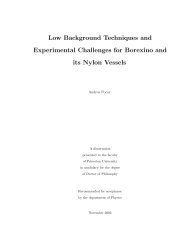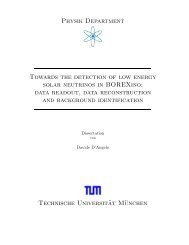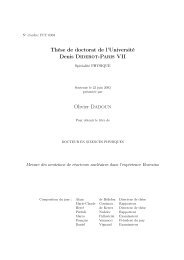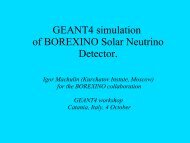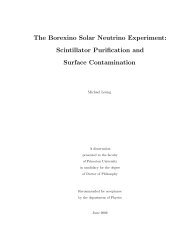Development of a Liquid Scintillator and of Data ... - Borexino - Infn
Development of a Liquid Scintillator and of Data ... - Borexino - Infn
Development of a Liquid Scintillator and of Data ... - Borexino - Infn
Create successful ePaper yourself
Turn your PDF publications into a flip-book with our unique Google optimized e-Paper software.
6.3 The PXE Tests in the CTF<br />
in equilibrium with their progenitors Ra (t a) <strong>and</strong> Th (t a), while<br />
the NAA directly measures the parent isotopes U <strong>and</strong> Th. Only in the case <strong>of</strong> secular<br />
equilibrium both methods would yield the same results. The uranium measurement in the CTF<br />
could be affected by a significant background coming from Rn in the water, that permeates<br />
through the nylon barrier (a very precise evaluation <strong>of</strong> this background is not possible; it might<br />
have as well reached a level <strong>of</strong> ¡ g U/g). The thorium measurement is not affected by<br />
such a kind <strong>of</strong> background. As can be seen from table 6.5, the values measured in the CTF1<br />
<strong>and</strong> with NAA are compatible with secular equilibrium in both decay chains.<br />
After the scintillator had been unloaded from the CTF, we continued the purification tests in<br />
the Module-0 with a water extraction <strong>of</strong> the 5 tons <strong>of</strong> scintillator with 2 tons <strong>of</strong> deionized water,<br />
<strong>and</strong> subsequently a circulation over a 40 l column (about 6 times the total volume). After each<br />
purification step a sample was taken for the NAA. In the end, a new record limit for the U<br />
<strong>and</strong> Th concentration in PXE was measured [vH99]:<br />
Í ¢ <br />
Ì ¢ <br />
After these operations the scintillator was stored in one <strong>of</strong> the EP tanks, while the CTF <strong>and</strong><br />
Module-0 were dismounted <strong>and</strong> upgraded during the years 1998 <strong>and</strong> 1999.<br />
6.3.3 The PXE Test in the CTF2 2000<br />
The PXE test in the CTF2 was carried out from May to September 2000. For the filling operations<br />
the upgraded Module-0 was used which also allowed to test this system for its performance<br />
<strong>and</strong> leak tightness.<br />
The PXE scintillator, that had been used for the test in CTF1 in 1996, was stored underground<br />
in one 7-ton tank <strong>of</strong> Module-0 during the last years <strong>and</strong> was used again for the new test in<br />
CTF2. The scintillator composition was È ÌÈ Ð ×ÅË ÑÐ . As the exact<br />
status <strong>of</strong> the scintillator was unknown (the tank had been opened several times during the last<br />
years to change flanges <strong>and</strong> sealings, <strong>and</strong> to connect the new pipes), we decided to clean the<br />
whole scintillator by running it in batches over a 40 l Silica gel column. The Silica gel was<br />
preconditioned by heating it up to about 100 Æ C <strong>and</strong> flushing it continuously with nitrogen<br />
for about 15 h to remove adsorbed water. The column operation needed about 1 day per ton<br />
scintillator. The scintillator was continuously running over the column with a flow rate <strong>of</strong><br />
1.5 - 2.5 l/min <strong>and</strong> from there into one <strong>of</strong> the two 1-ton-buffer-tanks, where it was flushed with<br />
nitrogen (RN ) to remove the Rn introduced by Rn-emanation from the silica gel (see fig.<br />
6.4). Once one <strong>of</strong> the buffer tanks was completely filled, the nitrogen flushing was continued<br />
for several hours with high purity nitrogen ( ÕÑ ). For the filling the remaining gas<br />
volume at the top <strong>of</strong> the buffer tank was filled up with deionized water, then the tank was<br />
connected to the CTF Inner Vessel <strong>and</strong> the scintillator was pumped into the Inner Vessel by<br />
85



